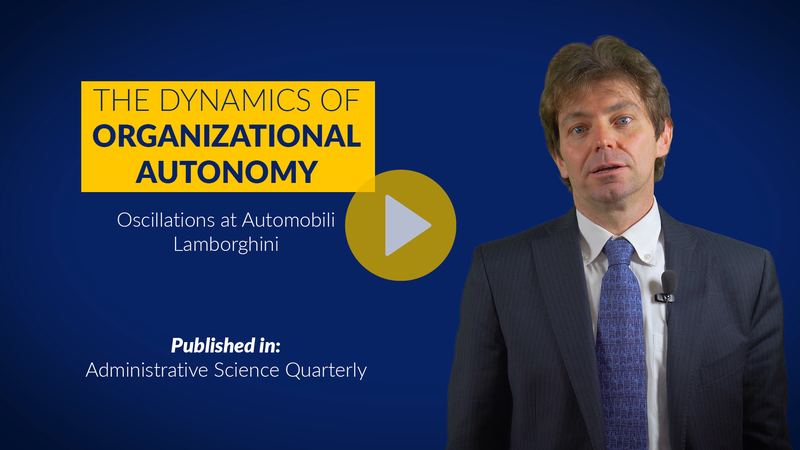The Dynamics of Organizational Autonomy: Oscillations at Automobili Lamborghini
Published in: Administrative Science Quarterly

What is the degree of organizational autonomy should a unit – be it a team, a department, or a business unit – have over the resources it manages?
This is a key question in any organizational design. Organizational autonomy is the extent of the unit’s discretion over how it builds, employs, and leverage – in a word, how it “orchestrates” – its resources.
The degree of organization autonomy becomes salient, particularly as soon as units are defined within a broader organization or a firm is integrated into a new parent organization through an acquisition.
This process involves a strategic tension that can arise between parent managers, who are eager to achieve firm-wide economies of scope and integration across units (thus reducing a unit’s organizational autonomy), and unit managers, who may expect to protect their specificity and discretion over resource orchestration decisions (thus preserving or extending their organizational autonomy).
Resolving this tension is a fundamental yet challenging dilemma. We recognized it while investigating the case of Automobili Lamborghini, the Italian world-renowned supercar manufacturer.
When in 2010 we started this research the company was experiencing an extraordinary renaissance, and we were particularly attracted by the ability that this technology-based luxury firm showed to develop and maintain a competitive advantage while it was heavily depending on its innovation ecosystem – e.g., on its suppliers, and on its parent company Audi AG, the German carmaker that owns Lamborghini since 1998.
The relationship between Lamborghini and its parent company looked quite unusual and could barely be explained by the current knowledge on organizational autonomy and mergers & acquisitions (M&A). Particularly, post-acquisition integration studies typically assume that the unit autonomy is progressively reduced until the “full amalgamation” of the target. Surprisingly, however, Lamborghini – after an initial period (approximately 10 years) of intense integration, had started to regain significant autonomy for the development of its new flagship, the “Aventador” – a truly revolutionary ultimate sport car.
This scenery posed a new fascinating question: how and why did this happen? We embarked on an exciting research journey that lasted more than 12 years, through which we continued to observe and analyze the evolution of the relationship between Lamborghini and Audi and those between Lamborghini and its key suppliers.
We observed the ongoing dialectics between Lamborghini’s and Audi’s managers and their respective instances for autonomy increase and reduction – which led to repeated reversals in the autonomy dynamics and “oscillations” in the Lamborghini managers’ discretion over resource orchestration.
Finally, we developed a model that offers a novel and valuable explanation for the emerging dynamics suggested by the data. Our model suggests that the dialectic which shapes the autonomy’s trajectory is driven by the parent managers’ appraisal respect for the unit (that means broadly: do the parent managers recognize the competence of Lamborghini managers?), their search for firm-wide strategic integration, and by the unit managers’ organizational identity and concern for distinctiveness (something like “What a Lamborghini should be”…).
Parent managers’ appraisal respect for Lamborghini was low in the very first post-acquisition period – as the company was in bad shape and close to failure – and they drove intense efforts to reduce autonomy. They injected skills and resources into Lamborghini, including shared parts and suppliers and common procedures. These synergies, which were very successful with the Gallardo, led to a turnaround of Lamborghini’s performance which increased the parent managers’ appraisal respect: “Ok, Lamborghini is indeed doing a good job…”. Yet, this success was also at the expense of Lamborghini’s distinctiveness – apparently, Lamborghini was stepping towards full amalgamation, in line with the common expectations after an acquisition.
But something different actually happened. When the time for developing the new supercar model came (2007), with Audi’s proposal to adopt the new V12 engine based on the group’s platform, Lamborghini managers felt they should protect the company’s distinctiveness: they believed that the pressure for integration was creating a gap with the vision they had for the company’s identity. They wanted to regain autonomy to re-establish some distinctiveness. And the appraisal respect they had won before was crucial to actually obtaining this freedom. Lamborghini was allowed to orchestrate its own resources in developing the Aventador, which resulted in a spectacular concentration of radical innovations (the carbon monocoque, the innovative gearbox system, and many others) – many of them developed in collaboration with exclusive suppliers – and in a supercar that thunderously reaffirmed the unique identity of Lamborghini.
Yet the story was still not at its end. With the success, also more managerial complexity came and a higher need for more established and standardized procedures – essentially, a renewed pressure for autonomy reduction arose, and the oscillations in the degree of autonomy continued.
Overall, our model suggests that the degree of autonomy of a unit company is constantly negotiated between the parent’s and unit’s managers, and it also captures the key mechanisms governing this dialectics, which eventually shapes autonomy in terms of the degree of managerial discretion the unit is able to gain on the orchestration of its resources.
Read the full article
Authors at the Department of Management
Paolo Barbieri – Associate Professor
Academic disciplines: Business and management engineering
Teaching areas: Procurement and Supply Chain Management
Research fields: Buyer-Supplier Relationships, Global Supply Chain Management, and Reshoring
Paolo is an Associate Professor at the Department of Management and a Core Faculty member at Bologna Business School. He has been a Visiting Professor at Michigan State University, Clarkson University, and Bayes Business School. His research interests include buyer-supplier relationships and global SCM. He’s the scientific director of the “Reshoring ER” Research Group and the scientific co-director of the “Re4IT-Reshoring Italy” and of the “SCBA-Supply Chain Business Analytics” Research Groups.
